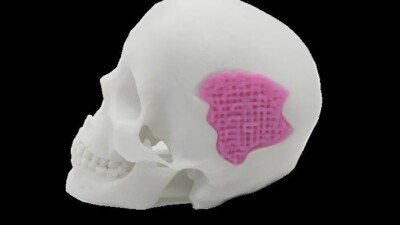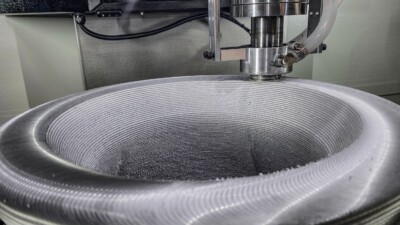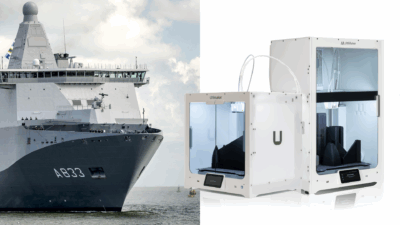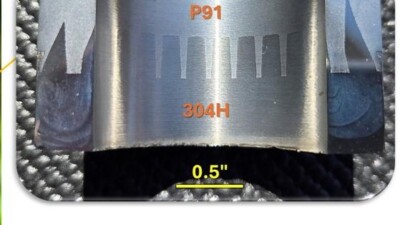engineering.com’s August webinar series will delve into the past and future of additive manufacturing.
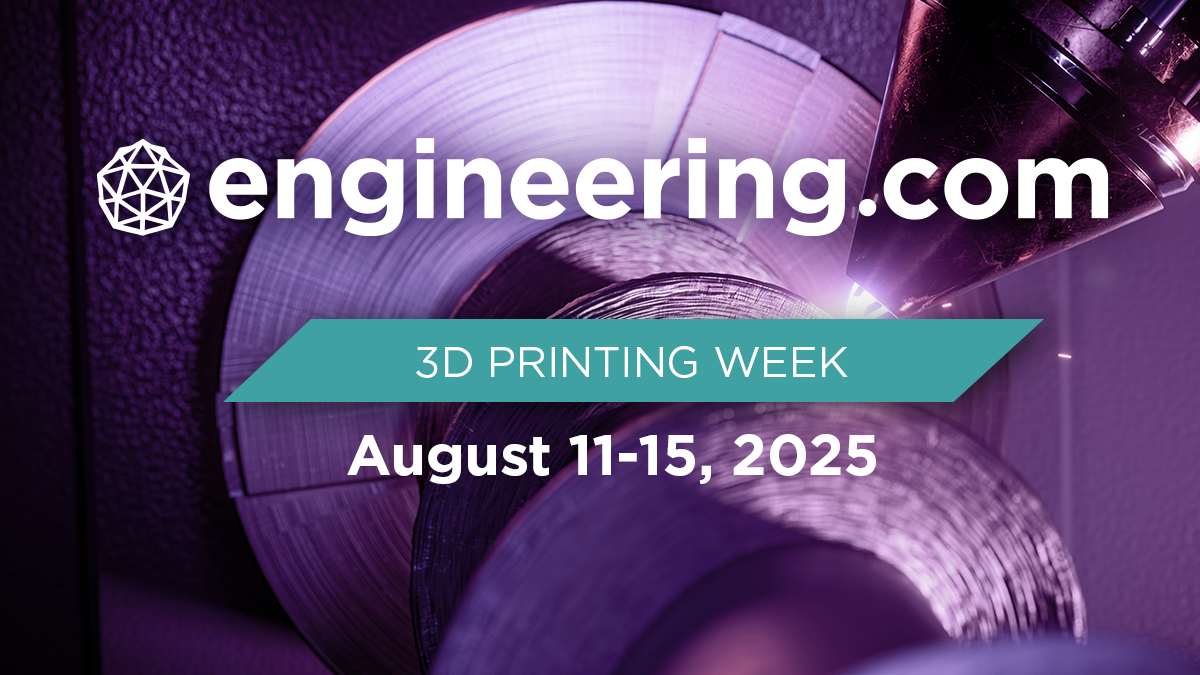
The last few years have been interesting times for the additive manufacturing (AM) industry, to put it mildly. Since its inception four decades ago, 3D printing technology has gone from a curious concept to a potential production game-changer. That journey has been anything but a straight line, and there are doubtless many more twists and turns on the road ahead.
One thing is certain, however: today’s engineers need to have a strong understanding of 3D printing technology and what it can (and can’t) do for them. That’s why we’re launching the inaugural engineering.com 3D Printing Week starting on August 11.
In this series of webinars, we’ll be covering everything from the history of 3D printing and the AM industry, to how additive technologies mesh with conventional subtractive manufacturing processes, to building a business case for AM. Expect deep coverage of industries leading the charge on applications for this technology, including aerospace, defense, and medical devices, and maybe even a few surprises along the way.
You’ll see how other engineers are using 3D printing, learn how to bring it into your own design and manufacturing workflows, and have the chance to interact directly with our expert guests.
Registrations are now open. Here’s what’s in store for the week:
August 11: A History of Failure in 3D Printing
12:00 PM Eastern Daylight Time
The AM industry has reached an inflection point, and not for the first time. As a technology, 3D printing has seen more progress (and more false promises) over the past 40 years than most see in a century.
From the consumer market collapse to the chasm between prototyping and production, this webinar charts a course through the trials and tribulations of 3D printing to explore how we got to where we are today and what we can learn from the mistakes and missteps of the past.
What you’ll learn:
- Gain valuable insights from the evolution of 3D printing technology
- Understand the fundamental hurdles for additive manufacturing
- Recognize where 3D printing technology excels and where it falters
August 12: Hybrid Manufacturing Demystified: When to Print, When to Machine, and Why it Matters
12:00 PM Eastern Daylight Time
The manufacturing landscape is evolving, and so are the tools and strategies available to engineers and sourcing leaders. As AM continues to mature, the line between “when to print” and “when to machine” is becoming more nuanced. Hybrid manufacturing leveraging both additive and traditional technologies is now a viable strategy for accelerating product development, optimizing cost, and supporting agile supply chains.
In this session, we’ll explore how hybrid manufacturing works, where it delivers the most value, and what challenges to consider. You’ll also learn when additive manufacturing makes sense from a business perspective looking at key drivers like low-volume production, lead time, and design complexity and how to evaluate costs and trade-offs compared to CNC or molding. Whether you’re prototyping, planning production, or rethinking a legacy part, this session will help you make informed, cost-effective decisions.
What you’ll learn:
- Learn about the pros and cons of hybrid manufacturing, what it is, and the core technologies enabling it
- Benefits such as reduced lead times, complex geometry finishing, material efficiency, and repair/rework applications will be discussed.
- See drawbacks analyzed, including machine cost, workflow complexity, programming expertise required, and part size constraints.
- Understand how to evaluate business cases for 3D printed parts
- Identify when AM is ideal: during low-volume production, rapid prototyping, weight reduction, or supply chain resilience.
- How to compare unit cost, tooling cost, lead time, and total cost for additive versus CNC or molding.
August 13: Built to Break, Designed to Protect: Developing and Implementing 3D-Printed Crushable Lattices for Space Exploration
12:00PM Eastern Daylight Time
NASA’s Jet Propulsion Laboratory (JPL), is exploring the use of 3D-printed titanium lattice structures as energy attenuators for the planned Mars Sample Return campaign. In the original architecture, the final phase of the campaign would involve a ballistic landing on Earth – no powered descent, no parachute, just a terminal velocity impact of about 50 m/s (112 mph) – requiring a specialized approach to protect the scientific integrity of the samples.
Lattices, with their unique mechanical properties, are ideal for dissipating landing loads, especially when manufactured through additive techniques that allow for spatially tuned properties and integrated features like mounting bosses. This reduces the need for assembly and potential points of failure while enabling the use of high-performance materials like titanium.
In this presentation, Ryan Watkins will share the development and proposed implementation story — from the challenges of manufacturing and designing these complex structures to the successes and setbacks that shaped our approach.
Beyond the technical narrative, this story serves as a lens into the broader adoption of additive manufacturing at NASA, where innovation must balance against a culture of necessary conservatism. Infusing new technology into flight systems is not just a technical hurdle but a human challenge, requiring trust and a shift in mindset. By reflecting on this journey, we can better understand what it takes to bridge cutting-edge technology with mission-critical applications, paving the way for future innovations in space exploration.
What you’ll learn:
- Understand how NASA is using 3D printing in spacecraft structures.
- The challenges and manufacturing approaches to 3D printing lattice structures.
- How to design lattice structures.
August 14: The Business Case for Additive in Defense
12:00 PM Eastern Daylight Time
The AM industry has been gaining traction in the defense sector in recent years. From making additive jet engine parts, to front-line deployments of containerized drone manufacturing, to using metal 3D printers for repairing naval ships at sea, the number and variety of additive applications in defense has grown prodigiously.
For many enterprising engineers, this might suggest that the defense sector is one of the best ways to grow a business using AM, but the business case for additive in defense is more complicated than it may appear.
Join us for this webinar with Tali Rosman to take a deep dive into how the defense sector is shaping the business case for AM, and how AM is transforming the defense sector in turn.
What you’ll learn:
- Learn about the most promising defense applications for additive manufacturing.
- Understand the challenges of making a business case for additive manufacturing in defense and how to overcome them.
- Engage with an industry expert for unique insights into additive manufacturing for defense.
August 15: Additive Manufacturing Applications in Aerospace and Medical Devices
12:00 PM Eastern Daylight Time
Two of the biggest industries for AM are aerospace and medical devices. From complex geometries and customization to lighter or more biocompatible materials, 3D printing technology has advanced the state of the art of manufacturing in both of these industries.
In this webinar, Ian Wright and Jim Hammerand will sit down together to discuss their unique perspectives and compare notes on how AM fits into aerospace and medical devices.
What do these two industries share in common that makes them good candidates for leveraging the benefits of 3D printing? What are the challenges they face? What can one industry learn from the other? Join us to find out!
What you’ll learn:
- Learn about new and exciting AM applications in aerospace and medical devices
- Understand the benefits and challenges of 3D printing components for these industries
- Engage with other industry experts to learn how their experiences can inform you
Don’t miss out! Register now for engineering.com’s 3D Printing Week 2025.
